The Impacts of Gustiness on Air–Sea Momentum Flux
Abstract
:1. Introduction
2. Data and Methods
2.1. Data
2.2. Gustiness Formulation
3. Results
4. Discussion
4.1. Gustiness and Vertical Oscillation
4.2. Possible Reason and Evidence for the Increased Momentum Fluxes
5. Summary and Conclusions
Author Contributions
Funding
Data Availability Statement
Acknowledgments
Conflicts of Interest
References
- Miles, J.W. On the generation of surface waves by shear flows. J. Fluid Mech. 1957, 3, 185–204. [Google Scholar] [CrossRef]
- Melville, W.; Romero, L.; Kleiss, J.; Swift, R. Extreme wave events in the Gulf of Tehuantepec. In Proceedings of the Rogue Waves: Proceedings 14th ‘Aha Huliko ‘a Hawaiian Winter Workshop, Manoa, HI, USA, 24–28 January 2005; pp. 23–28. [Google Scholar]
- Young, I.R.; Banner, M.L.; Donelan, M.A.; McCormick, C.; Babanin, A.V.; Melville, W.K.; Veron, F. An integrated system for the study of wind-wave source terms in finite-depth water. J. Atmos. Ocean. Technol. 2005, 22, 814–831. [Google Scholar] [CrossRef]
- Zavarsky, A.; Booge, D.; Fiehn, A.; Krüger, K.; Atlas, E.; Marandino, C. The influence of air-sea fluxes on atmospheric aerosols during the summer monsoon over the tropical Indian Ocean. Geophys. Res. Lett. 2018, 45, 418–426. [Google Scholar] [CrossRef] [Green Version]
- Fan, Y.; Ginis, I.; Hara, T. The effect of wind–wave–current interaction on air–sea momentum fluxes and ocean response in tropical cyclones. J. Phys. Oceanogr. 2009, 39, 1019–1034. [Google Scholar] [CrossRef] [Green Version]
- Kara, A.B.; Metzger, E.J.; Bourassa, M.A. Ocean current and wave effects on wind stress drag coefficient over the global ocean. Geophys. Res. Lett. 2007, 34, L01604. [Google Scholar] [CrossRef]
- Kara, B.; Metzger, J.; Bourassa, M. Impacts of Ocean Currents and Waves on the Wind Stress Drag Coefficient: Relevance to Hycom; Naval Research Lab Stennis Detachment Stennis Space Center MS: Stennis Space Center, Kiln, MS, USA, 2006. [Google Scholar]
- Roberts, M.J.; Camp, J.; Seddon, J.; Vidale, P.L.; Hodges, K.; Vannière, B.; Mecking, J.; Haarsma, R.; Bellucci, A.; Scoccimarro, E. Projected future changes in tropical cyclones using the Cmip6 Highresmip multimodel ensemble. Geophys. Res. Lett. 2020, 47, e2020GL088662. [Google Scholar] [CrossRef]
- Potter, H.; Drennan, W.M.; Graber, H.C. Upper ocean cooling and air-sea fluxes under typhoons: A case study. J. Geophys. Res. Ocean. 2017, 122, 7237–7252. [Google Scholar] [CrossRef]
- Moum, J.; Smyth, W. Upper ocean mixing processes. Encycl. Ocean Sci. 2001, 6, 3093–3100. [Google Scholar]
- Rogers, R.; Aberson, S.; Black, M.; Black, P.; Cione, J.; Dodge, P.; Dunion, J.; Gamache, J.; Kaplan, J.; Powell, M. The Intensity Forecasting Experiment: A NOAA multiyear field program for improving tropical cyclone intensity forecasts. Bull. Am. Meteorol. Soc. 2006, 87, 1523–1538. [Google Scholar] [CrossRef] [Green Version]
- Chalikov, D.; Rainchik, S. Coupled numerical modelling of wind and waves and the theory of the wave boundary layer. Bound.-Layer Meteorol. 2011, 138, 1–41. [Google Scholar] [CrossRef]
- Monin, A.; Iaglom, A.; Lumley, J. Statistical Fluid Mechanics: Mechanics of Turbulence; Revised and Enlarged Edition; MIT Press: Cambridge, MA, USA, 1975; Volume 2. [Google Scholar]
- Buckley, M.P.; Veron, F. Structure of the airflow above surface waves. J. Phys. Oceanogr. 2016, 46, 1377–1397. [Google Scholar] [CrossRef] [Green Version]
- Benilov, A.; Gumbatov, A.; Zaslavsky, M.; Kitaigorodskii, S. Non-Steady Model of Development of Turbulent Boundary Layer Above Sea under Generating of Surface Waves. Izv. Acad. Sci. USSR Atmos. Ocean Phys. 1978, 14, 1177. [Google Scholar]
- Chalikov, D.; Belevich, M.Y. One-dimensional theory of the wave boundary layer. Bound.-Layer Meteorol. 1993, 63, 65–96. [Google Scholar] [CrossRef]
- Chalikov, D. The parameterization of the wave boundary layer. J. Phys. Oceanogr. 1995, 25, 1333–1349. [Google Scholar] [CrossRef] [Green Version]
- Makin, V.; Mastenbroek, C. Impact of waves on air-sea exchange of sensible heat and momentum. Bound.-Layer Meteorol. 1996, 79, 279–300. [Google Scholar] [CrossRef]
- Donelan, M.A.; Drennan, W.M.; Katsaros, K.B. The air–sea momentum flux in conditions of wind sea and swell. J. Phys. Oceanogr. 1997, 27, 2087–2099. [Google Scholar] [CrossRef]
- Thomson, J.; D’Asaro, E.; Cronin, M.; Rogers, W.; Harcourt, R.; Shcherbina, A. Waves and the equilibrium range at Ocean Weather Station P. J. Geophys. Res. Ocean. 2013, 118, 5951–5962. [Google Scholar] [CrossRef]
- Large, W.; Pond, S. Open ocean momentum flux measurements in moderate to strong winds. J. Phys. Oceanogr. 1981, 11, 324–336. [Google Scholar] [CrossRef] [Green Version]
- Potter, H.; Rudzin, J.E. Upper Ocean Temperature Variability in the Gulf of Mexico with Implications for Hurricane Intensity. J. Phys. Oceanogr. 2021. [Google Scholar] [CrossRef]
- Zedler, S.E.; Kanschat, G.; Korty, R.; Hoteit, I. A new approach for the determination of the drag coefficient from the upper ocean response to a tropical cyclone: A feasibility study. J. Oceanogr. 2012, 68, 227–241. [Google Scholar] [CrossRef]
- Smith, S.D.; Anderson, R.J.; Oost, W.A.; Kraan, C.; Maat, N.; De Cosmo, J.; Katsaros, K.B.; Davidson, K.L.; Bumke, K.; Hasse, L. Sea surface wind stress and drag coefficients: The HEXOS results. Bound.-Layer Meteorol. 1992, 60, 109–142. [Google Scholar] [CrossRef] [Green Version]
- Smith, S.D. Wind stress and heat flux over the ocean in gale force winds. J. Phys. Oceanogr. 1980, 10, 709–726. [Google Scholar] [CrossRef]
- Smedman, A.; Högström, U.; Bergström, H.; Rutgersson, A.; Kahma, K.; Pettersson, H. A case study of air-sea interaction during swell conditions. J. Geophys. Res. Ocean. 1999, 104, 25833–25851. [Google Scholar] [CrossRef]
- Collins, C.O.; Potter, H.; Lund, B.; Tamura, H.; Graber, H.C. Directional wave spectra observed during intense tropical cyclones. J. Geophys. Res. Ocean. 2018, 123, 773–793. [Google Scholar] [CrossRef]
- Holthuijsen, L.H.; Powell, M.D.; Pietrzak, J.D. Wind and waves in extreme hurricanes. J. Geophys. Res. Ocean. 2012, 117. [Google Scholar] [CrossRef] [Green Version]
- Lin, S.; Sheng, J. Revisiting dependences of the drag coefficient at the sea surface on wind speed and sea state. Cont. Shelf Res. 2020, 207, 104188. [Google Scholar] [CrossRef]
- Fairall, C.W.; Bradley, E.F.; Hare, J.; Grachev, A.A.; Edson, J.B. Bulk parameterization of air–sea fluxes: Updates and verification for the COARE algorithm. J. Clim. 2003, 16, 571–591. [Google Scholar] [CrossRef]
- Babanin, A.V.; Makin, V.K. Effects of wind trend and gustiness on the sea drag: Lake George study. J. Geophys. Res. Ocean. 2008, 113. [Google Scholar] [CrossRef]
- Stewart, R. The air-sea momentum exchange. Bound.-Layer Meteorol. 1974, 6, 151–167. [Google Scholar] [CrossRef]
- Drennan, W.M.; Graber, H.C.; Hauser, D.; Quentin, C. On the wave age dependence of wind stress over pure wind seas. J. Geophys. Res. Ocean. 2003, 108. [Google Scholar] [CrossRef]
- Yelland, M.; Moat, B.; Taylor, P.; Pascal, R.; Hutchings, J.; Cornell, V. Wind stress measurements from the open ocean corrected for airflow distortion by the ship. J. Phys. Oceanogr. 1998, 28, 1511–1526. [Google Scholar] [CrossRef]
- Gao, Z.; Wang, Q.; Wang, S. An alternative approach to sea surface aerodynamic roughness. J. Geophys. Res. Atmos. 2006, 111. [Google Scholar] [CrossRef] [Green Version]
- Oost, W.A.; Komen, G.J.; Jacobs, C.M.; van Oort, C.; Bonekamp, H. Indications for a wave dependent Charnock parameter from measurements during ASGAMAGE. Geophys. Res. Lett. 2001, 28, 2795–2797. [Google Scholar] [CrossRef]
- Dobson, F.W.; Smith, S.D.; Anderson, R.J. Measuring the relationship between wind stress and sea state in the open ocean in the presence of swell. Atmos.-Ocean 1994, 32, 237–256. [Google Scholar] [CrossRef] [Green Version]
- Drennan, W.M.; Kahma, K.K.; Donelan, M.A. On momentum flux and velocity spectra over waves. Bound.-Layer Meteorol. 1999, 92, 489–515. [Google Scholar] [CrossRef]
- Potter, H. Swell and the drag coefficient. Ocean Dyn. 2015, 65, 375–384. [Google Scholar] [CrossRef]
- Drennan, W.M.; Graber, H.C.; Donelan, M.A. Evidence for the effects of swell and unsteady winds on marine wind stress. J. Phys. Oceanogr. 1999, 29, 1853–1864. [Google Scholar] [CrossRef]
- Vincent, C.L.; Thomson, J.; Graber, H.C.; Collins, C.O., III. Impact of swell on the wind-sea and resulting modulation of stress. Prog. Oceanogr. 2019, 178, 102164. [Google Scholar] [CrossRef]
- Vincent, C.L.; Graber, H.C.; Collins, C.O., III. Effect of Swell on Wind Stress for Light to Moderate Winds. J. Atmos. Sci. 2020, 77, 3759–3768. [Google Scholar] [CrossRef]
- Wüest, A.; Lorke, A. Small-scale hydrodynamics in lakes. Annu. Rev. Fluid Mech. 2003, 35, 373–412. [Google Scholar] [CrossRef]
- Kenyon, K.E.; Sheres, D. Wave force on an ocean current. J. Phys. Oceanogr. 2006, 36, 212–221. [Google Scholar] [CrossRef]
- Kader, B.; Yaglom, A. Mean fields and fluctuation moments in unstably stratified turbulent boundary layers. J. Fluid Mech. 1990, 212, 637–662. [Google Scholar] [CrossRef]
- Foken, T. 50 years of the Monin–Obukhov similarity theory. Bound.-Layer Meteorol. 2006, 119, 431–447. [Google Scholar] [CrossRef]
- Zeng, X.; Zhao, M.; Dickinson, R.E. Intercomparison of bulk aerodynamic algorithms for the computation of sea surface fluxes using TOGA COARE and TAO data. J. Clim. 1998, 11, 2628–2644. [Google Scholar] [CrossRef]
- Obukhov, A. Charakteristiki mikrostruktury vetra v prizemnom sloje atmosfery (Characteristics of the micro-structure of the wind in the surface layer of the atmosphere). Izv. AN SSSR Ser. Geofiz. 1951, 3, 49–68. [Google Scholar]
- Obukhov, A. Turbulentnost’v temperaturnoj-neodnorodnoj atmosfere. Tr. Inst. Theor. Geofiz. AN SSSR 1946, 1, 95–115. [Google Scholar]
- Monin, A.S.; Obukhov, A.M. Basic laws of turbulent mixing in the surface layer of the atmosphere. Contrib. Geophys. Inst. Acad. Sci. USSR 1954, 151, e187. [Google Scholar]
- Vignon, E.; Genthon, C.; Barral, H.; Amory, C.; Picard, G.; Gallée, H.; Casasanta, G.; Argentini, S. Momentum-and heat-flux parametrization at Dome C, Antarctica: A sensitivity study. Bound.-Layer Meteorol. 2017, 162, 341–367. [Google Scholar] [CrossRef]
- Janssen, P. On the effects of gustiness on wave growth. In KNMI Afdeling Oceanografisch Onderzoek Memo; Koninklijk Nederlands Meteorologisch Instituut: De Bilt, The Netherlands, 1986. [Google Scholar]
- Miles, J.; Ierley, G. Surface-wave generation by gusty wind. J. Fluid Mech. 1998, 357, 21–28. [Google Scholar] [CrossRef]
- Abdalla, S.; Cavaleri, L. Effect of wind variability and variable air density on wave modeling. J. Geophys. Res. Ocean. 2002, 107, 17-1–17-17. [Google Scholar] [CrossRef]
- Ponce, S.; Ocampo-Torres, F.J. Sensitivity of a wave model to wind variability. J. Geophys. Res. Ocean. 1998, 103, 3179–3201. [Google Scholar] [CrossRef] [Green Version]
- Pleskachevsky, A.L.; Lehner, S.; Rosenthal, W. Storm observations by remote sensing and influences of gustiness on ocean waves and on generation of rogue waves. Ocean Dyn. 2012, 62, 1335–1351. [Google Scholar] [CrossRef]
- Annenkov, S.; Shrira, V. Evolution of wave turbulence under “gusty” forcing. Phys. Rev. Lett. 2011, 107, 114502. [Google Scholar] [CrossRef]
- Uz, B.M.; Donelan, M.A.; Hara, T.; Bock, E.J. Laboratory studies of wind stress over surface waves. Bound.-Layer Meteorol. 2002, 102, 301–331. [Google Scholar] [CrossRef]
- Babanin, A.V.; McConochie, J. Wind measurements near the surface of waves. In Proceedings of the International Conference on Offshore Mechanics and Arctic Engineering, Nantes, France, 9–14 June 2013. [Google Scholar]
- Ting, C.H.; Babanin, A.V.; Chalikov, D.; Hsu, T.W. Dependence of drag coefficient on the directional spreading of ocean waves. J. Geophys. Res. Ocean. 2012, 117, C00J14. [Google Scholar] [CrossRef] [Green Version]
- D’Asaro, E.; Black, P.; Centurioni, L.; Chang, Y.-T.; Chen, S.; Foster, R.; Graber, H.; Harr, P.; Hormann, V.; Lien, R.-C. Impact of typhoons on the ocean in the Pacific. Bull. Am. Meteorol. Soc. 2014, 95, 1405–1418. [Google Scholar] [CrossRef]
- Miyake, M.; Stewart, R.; Burling, R. Spectra and cospectra of turbulence over water. Q. J. R. Meteorol. Soc. 1970, 96, 138–143. [Google Scholar] [CrossRef]
- Drennan, W.M.; Graber, H.C.; Collins, C., III; Herrera, A.; Potter, H.; Ramos, R.; Williams, N. EASI: An air–sea interaction buoy for high winds. J. Atmos. Ocean. Technol. 2014, 31, 1397–1409. [Google Scholar] [CrossRef]
- Collins, C.O.; Lund, B.; Ramos, R.J.; Drennan, W.M.; Graber, H.C. Wave measurement intercomparison and platform evaluation during the ITOP (2010) experiment. J. Atmos. Ocean. Technol. 2014, 31, 2309–2329. [Google Scholar] [CrossRef]
- Potter, H. The cold wake of typhoon Chaba (2010). Deep Sea Res. Part I Oceanogr. Res. Pap. 2018, 140, 136–141. [Google Scholar] [CrossRef]
- Potter, H.; Graber, H.C.; Williams, N.J.; Collins, C.O., III; Ramos, R.J.; Drennan, W.M. In situ measurements of momentum fluxes in typhoons. J. Atmos. Sci. 2015, 72, 104–118. [Google Scholar] [CrossRef]
- Anctil, F.; Donelan, M.A.; Drennan, W.M.; Graber, H.C. Eddy-correlation measurements of air-sea fluxes from a discus buoy. J. Atmos. Ocean. Technol. 1994, 11, 1144–1150. [Google Scholar] [CrossRef] [Green Version]
- Mörters, P.; Peres, Y. Brownian Motion; Cambridge University Press: Cambridge, UK, 2010; Volume 30. [Google Scholar]
- Drennan, W. On parameterisations of air-sea fluxes. Atmos.-Ocean Interact. 2006, 2, 1–34. [Google Scholar]
- Hersbach, H.; Janssen, P. Improvement of the short-fetch behavior in the Wave Ocean Model (WAM). J. Atmos. Ocean. Technol. 1999, 16, 884–892. [Google Scholar] [CrossRef]
- Haines, K. Ocean data assimilation. In Data Assimilation; Springer: Berlin/Heidelberg, Germany, 2010; pp. 517–547. [Google Scholar]
- Tamura, H.; Drennan, W.M.; Collins, C.O.; Graber, H.C. Turbulent airflow and wave-induced stress over the ocean. Bound.-Layer Meteorol. 2018, 169, 47–66. [Google Scholar] [CrossRef]

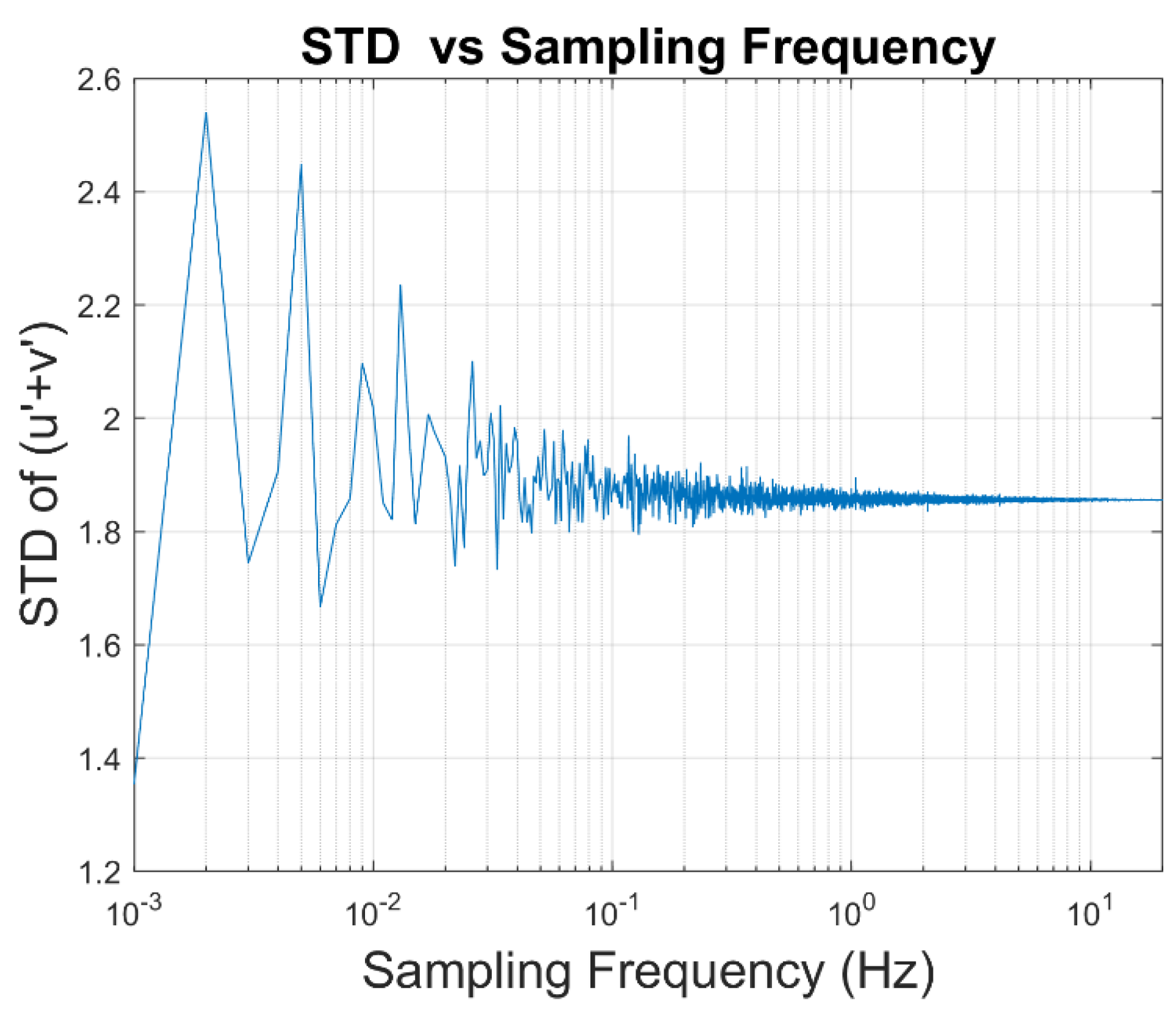






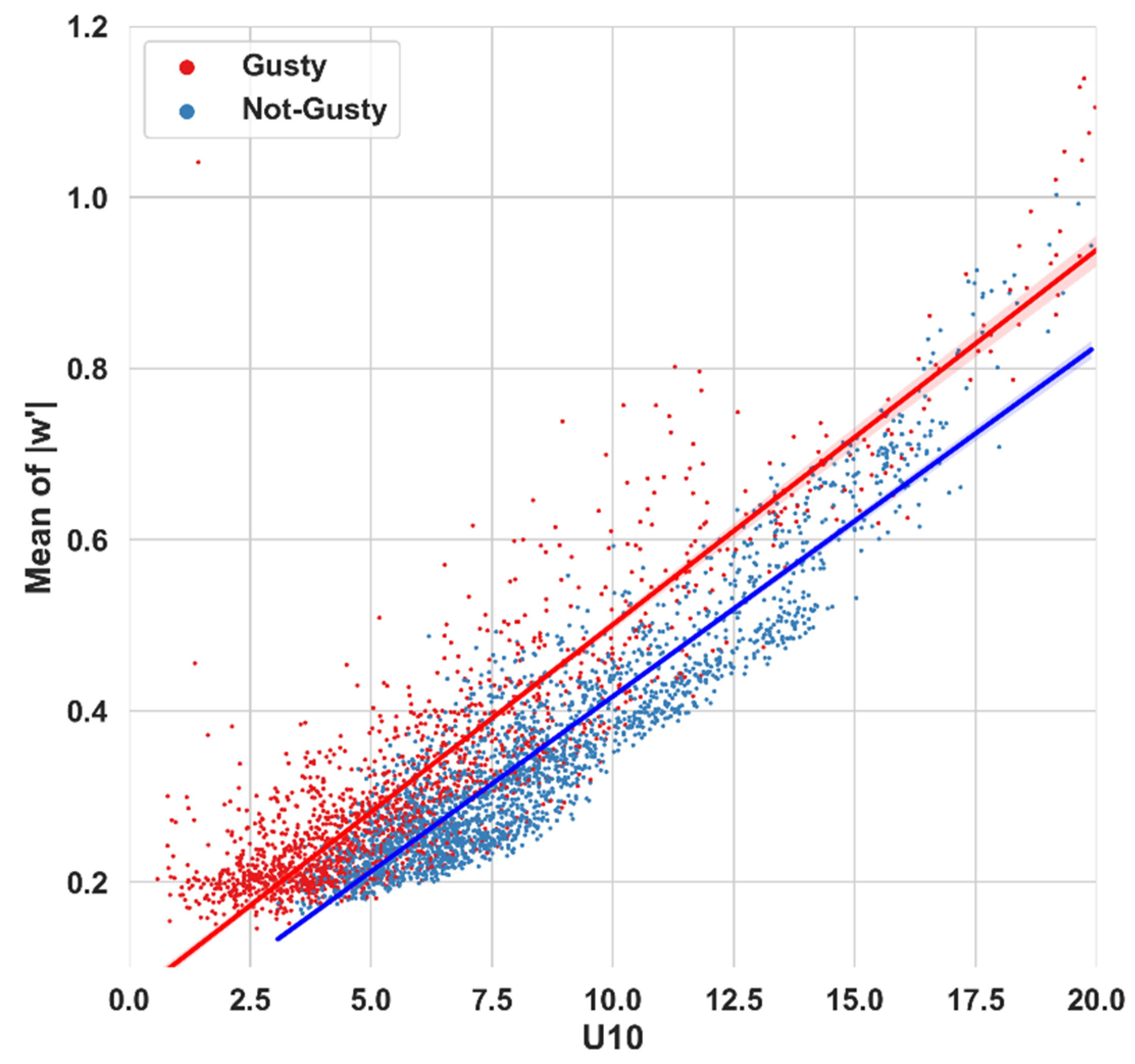
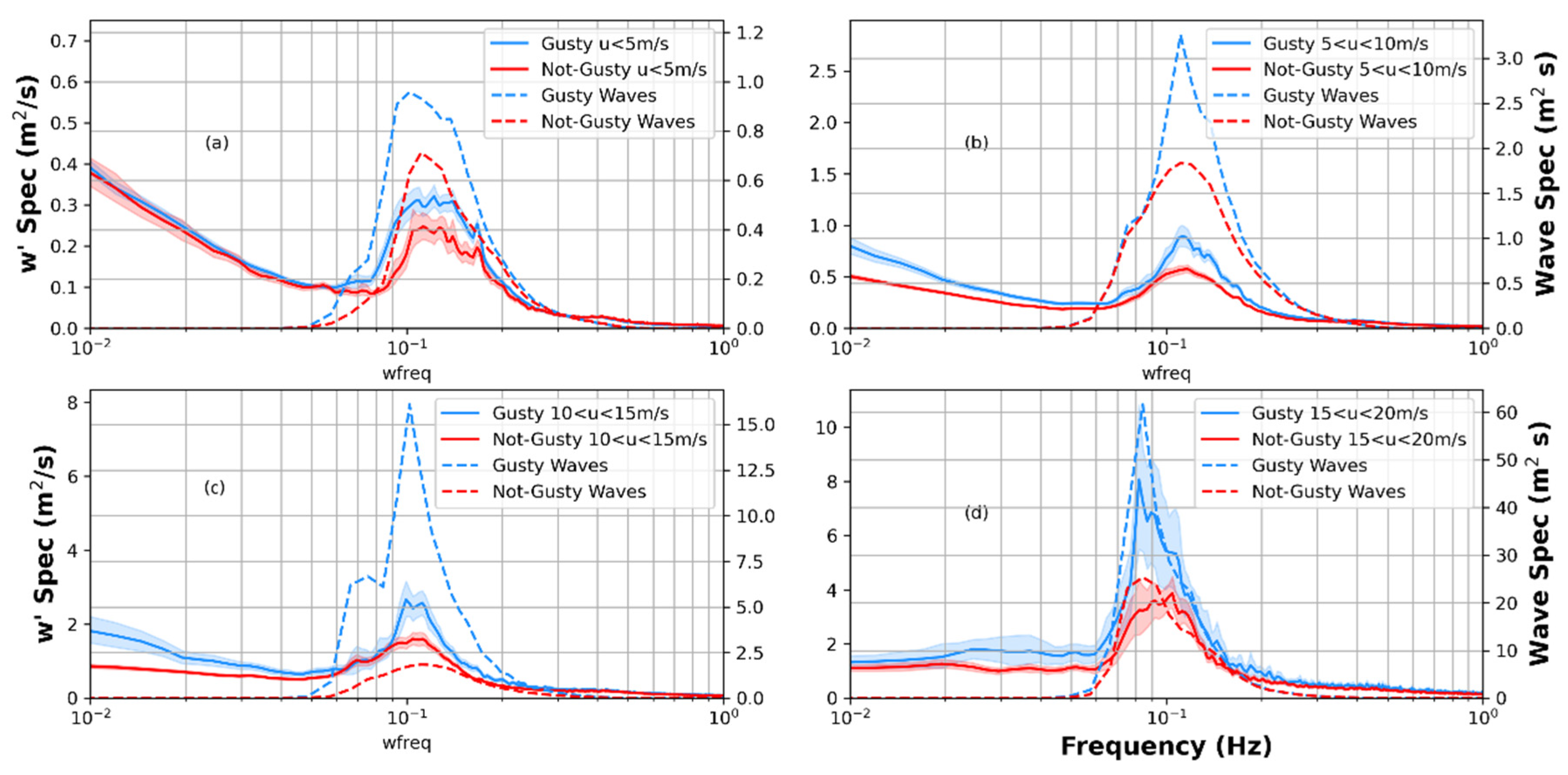
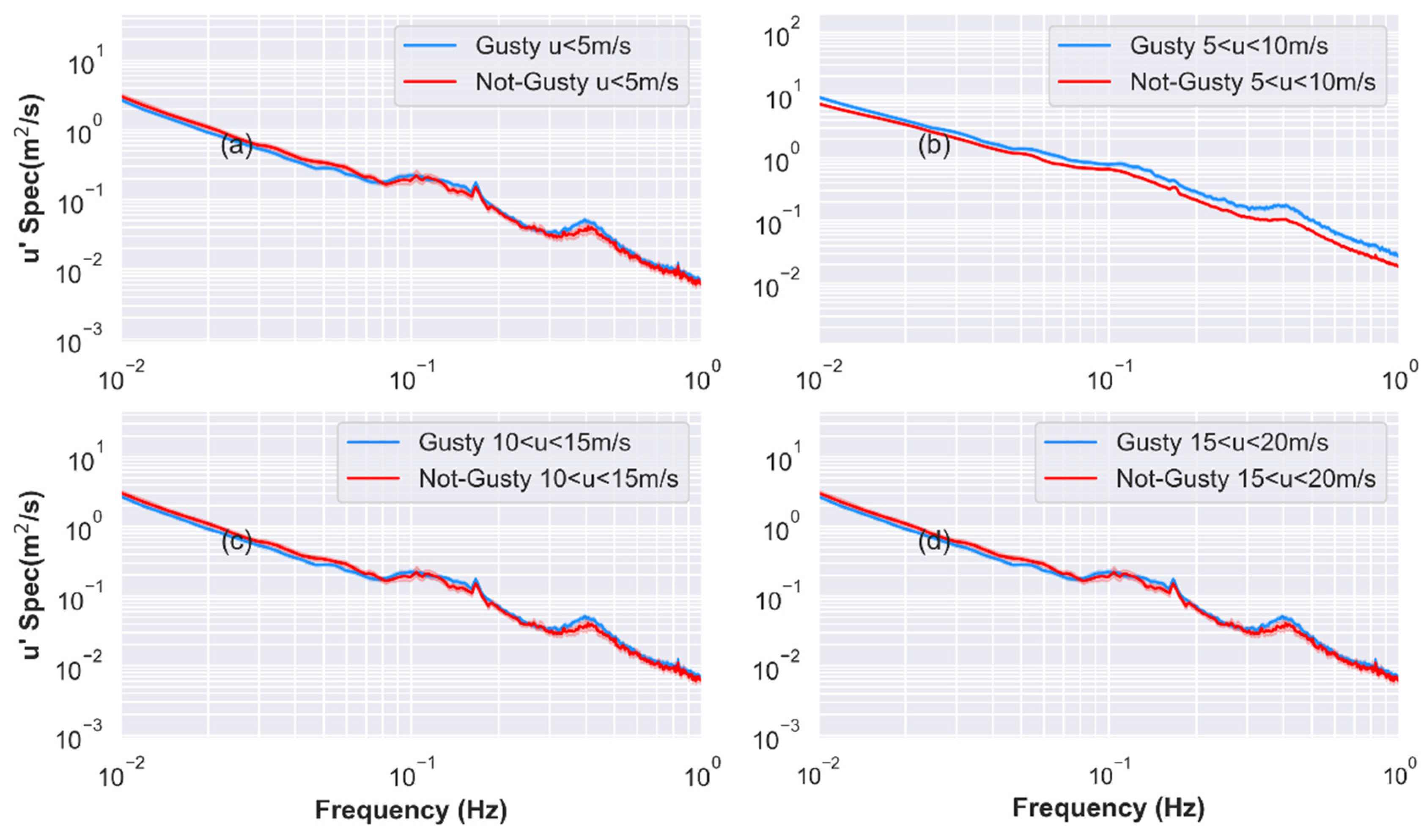

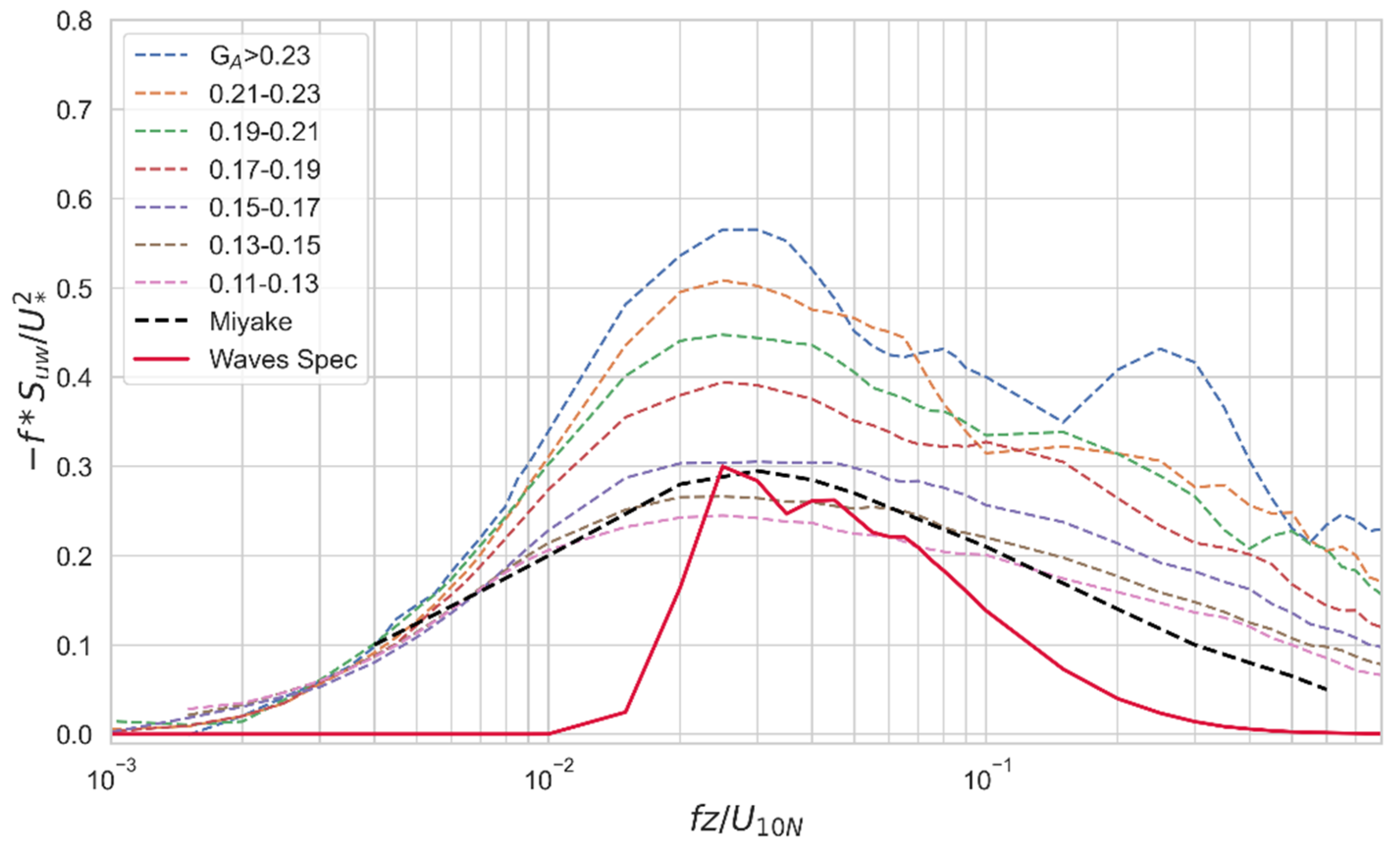
Publisher’s Note: MDPI stays neutral with regard to jurisdictional claims in published maps and institutional affiliations. |
© 2021 by the authors. Licensee MDPI, Basel, Switzerland. This article is an open access article distributed under the terms and conditions of the Creative Commons Attribution (CC BY) license (https://creativecommons.org/licenses/by/4.0/).
Share and Cite
Lyu, M.; Potter, H.; Collins, C.O. The Impacts of Gustiness on Air–Sea Momentum Flux. Fluids 2021, 6, 336. https://doi.org/10.3390/fluids6100336
Lyu M, Potter H, Collins CO. The Impacts of Gustiness on Air–Sea Momentum Flux. Fluids. 2021; 6(10):336. https://doi.org/10.3390/fluids6100336
Chicago/Turabian StyleLyu, Meng, Henry Potter, and Clarence O. Collins. 2021. "The Impacts of Gustiness on Air–Sea Momentum Flux" Fluids 6, no. 10: 336. https://doi.org/10.3390/fluids6100336
APA StyleLyu, M., Potter, H., & Collins, C. O. (2021). The Impacts of Gustiness on Air–Sea Momentum Flux. Fluids, 6(10), 336. https://doi.org/10.3390/fluids6100336





